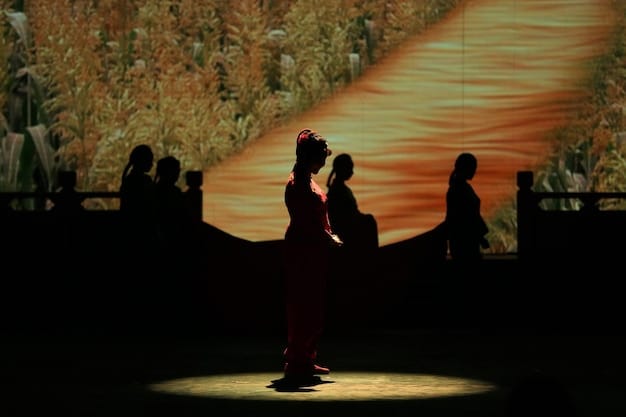Unveiling the World of K-Dramas: A Comprehensive Review

K-dramas have surged in popularity, captivating global audiences with their compelling narratives, high production values, and unique cultural insights, making them a significant force in the entertainment industry.
K-dramas, or Korean dramas, have become a global phenomenon, captivating audiences with their unique storytelling, compelling characters, and high production values. But what exactly makes them so popular?
What are K-Dramas? An Introduction
K-dramas, short for Korean dramas, are television series produced in South Korea. They are known for their diverse genres, ranging from romance and comedy to historical dramas and thrillers. K-dramas often feature high production values, talented actors, and captivating storylines that resonate with audiences worldwide.
The Rise of Hallyu
The term “Hallyu,” meaning “Korean Wave,” refers to the increasing global popularity of South Korean culture. K-dramas have played a significant role in the Hallyu phenomenon, introducing Korean culture, language, and lifestyle to a global audience. This cultural exchange has fostered a greater interest in South Korea and its entertainment industry.
Key Characteristics of K-Dramas
Several characteristics differentiate K-dramas from other television series. These include:
- Compelling Storylines: K-dramas often feature intricate plots with unexpected twists, keeping viewers engaged from beginning to end.
- High Production Values: The attention to detail in set design, cinematography, and costumes enhances the viewing experience.
- Talented Actors: K-dramas showcase talented actors who deliver memorable performances, creating strong emotional connections with viewers.
K-dramas have not only entertained but also educated viewers about Korean culture and society. Their popularity has led to increased tourism in South Korea and a greater appreciation for Korean traditions and customs.

The Global Appeal of K-Dramas
K-dramas have achieved phenomenal success on a global scale, attracting viewers from diverse backgrounds and cultures. Their universal themes and relatable characters have resonated with audiences worldwide, transcending cultural and linguistic barriers.
Factors Contributing to Global Popularity
Several factors have contributed to the global popularity of K-dramas:
- Accessibility through Streaming Platforms: The availability of K-dramas on popular streaming platforms like Netflix, Viki, and Hulu has made them easily accessible to a global audience.
- Social Media Influence: Social media platforms have played a significant role in promoting K-dramas, with fans sharing clips, reviews, and memes that generate buzz and attract new viewers.
- Positive Word-of-Mouth: Recommendations from friends and family have also contributed to the increased viewership of K-dramas, as satisfied viewers share their experiences with others.
Cultural Impact
The global popularity of K-dramas has had a significant cultural impact, influencing fashion, beauty, and lifestyle trends around the world.
The fashion styles showcased in K-dramas have inspired viewers to adopt Korean fashion trends, while the beauty products endorsed by K-drama actors have become highly sought after. This cultural exchange has fostered a greater appreciation for Korean culture and its influence on global trends.
K-dramas have successfully crossed borders because they explore universal human emotions and relationships in a unique cultural context.
Popular K-Drama Genres
K-dramas encompass a wide range of genres, each offering unique themes, characters, and storytelling styles. Some of the most popular genres include romance, comedy, historical dramas, and thrillers.
Romance Dramas
Romance dramas are a staple of K-dramas, often featuring heartwarming stories of love, friendship, and personal growth. These dramas typically focus on the relationships between the main characters, exploring themes of fate, destiny, and overcoming obstacles to find love.
Comedy Dramas
Comedy dramas offer lighthearted entertainment, often incorporating humor, satire, and slapstick to create a cheerful and uplifting viewing experience. These dramas often feature quirky characters, exaggerated situations, and witty dialogue that appeal to a wide audience.
Historical Dramas
Historical dramas, also known as sageuks, transport viewers to different historical periods in Korea, showcasing the lives of kings, queens, warriors, and commoners. These dramas often feature elaborate costumes, detailed set designs, and epic battle scenes that bring history to life.
Thriller Dramas
Thriller dramas offer suspenseful and gripping storylines, often exploring themes of crime, mystery, and psychological drama. These dramas feature intricate plots, unexpected twists, and intense performances that keep viewers on the edge of their seats.
Regardless of genre, K-dramas consistently deliver high-quality production and engaging storytelling that captivate audiences worldwide.
Iconic K-Dramas and Their Impact
Several K-dramas have achieved iconic status, captivating audiences and leaving a lasting impact on the entertainment industry. These dramas have set new standards for storytelling, production, and performance, influencing subsequent K-dramas and inspiring viewers worldwide.
“Crash Landing on You”
“Crash Landing on You” tells the story of a South Korean heiress who accidentally lands in North Korea and falls in love with a North Korean soldier. The drama’s unique premise, compelling characters, and heartwarming romance captivated audiences, making it one of the most popular K-dramas of all time.
“Goblin”
“Goblin,” also known as “Guardian: The Lonely and Great God,” follows the story of a goblin who seeks to end his immortal life by finding a human bride. The drama’s intricate plot, stunning visuals, and emotional performances resonated with viewers, earning it critical acclaim and widespread popularity.
“Descendants of the Sun”
“Descendants of the Sun” tells the story of a South Korean soldier and a doctor who fall in love while working in a war-torn country. The drama’s action-packed plot, romantic storyline, and charismatic leads captivated audiences, making it a global phenomenon.
“Kingdom”
“Kingdom” is a historical zombie thriller set in the Joseon period of Korea. The drama’s unique premise, stunning visuals, and suspenseful storyline have garnered critical acclaim and a dedicated fan base, showcasing the versatility and creativity of K-dramas.
These iconic K-dramas have not only entertained viewers but also pushed the boundaries of storytelling, showcasing the potential of K-dramas to captivate audiences worldwide.

The Evolution of K-Drama Production
K-drama production has undergone significant evolution over the years, with advancements in technology, storytelling, and creative approaches. These changes have enhanced the viewing experience and contributed to the global popularity of K-dramas.
Technological Advancements
Technological advancements have played a significant role in the evolution of K-drama production. The advent of high-definition cameras, sophisticated editing software, and computer-generated imagery (CGI) has allowed for visually stunning and immersive storytelling. These advancements have enhanced the viewing experience, making K-dramas more captivating and engaging.
Storytelling Techniques
Over the years, K-dramas have experimented with different storytelling techniques, incorporating elements of fantasy, science fiction, and psychological drama to create unique and innovative narratives. These techniques have broadened the appeal of K-dramas, attracting viewers with diverse interests and preferences.
- Flashbacks: Used to reveal character backstories and motivations.
- Symbolism: Incorporating symbolic elements like colors, objects, or recurring motifs to add depth and meaning to the narrative.
- Cliffhangers: Ending episodes with suspenseful cliffhangers to keep viewers hooked and eager for the next installment.
Creative Approaches
K-drama production has also embraced creative approaches to casting, music, and marketing, enhancing the overall viewing experience. The use of popular K-pop artists in soundtracks, cross-promotion with merchandise and events, and innovative social media campaigns have heightened the visibility of K-dramas and attracted new viewers.
The evolution of K-drama production has been a continuous process of innovation and adaptation, resulting in high-quality entertainment that captivates audiences worldwide.
The Future of K-Dramas
The future of K-dramas looks promising, with opportunities for continued growth, innovation, and global expansion. As technology advances and audience preferences evolve, K-dramas are poised to adapt and create new and exciting entertainment experiences.
Emerging Trends
Several emerging trends are shaping the future of K-dramas, including:
- Collaborations with International Production Companies: K-dramas are increasingly collaborating with international production companies to create co-productions that appeal to a global audience.
- Integration of Interactive Technologies: Interactive technologies like virtual reality (VR) and augmented reality (AR) are being integrated into K-drama production to create immersive and engaging viewing experiences.
- Focus on Diverse and Inclusive Storytelling: K-dramas are gradually incorporating diverse and inclusive storylines that reflect the experiences of marginalized communities, promoting greater understanding and empathy among viewers.
Challenges and Opportunities
The K-drama industry faces several challenges, including competition from other entertainment sources, changing audience preferences, and the need to maintain high production standards.
However, the K-drama industry also has several opportunities, including the potential to expand into new markets, create spin-offs and sequels, and leverage the power of fan communities to promote and support K-dramas.
By embracing innovation, collaboration, and inclusivity, K-dramas can continue to captivate audiences and shape the future of entertainment.
| Key Point | Brief Description |
|---|---|
| 🎬 Diverse Genres | From romance and comedy to historical and thriller, K-dramas offer a genre for everyone. |
| 🌍 Global Appeal | Universal themes and relatable characters resonate with audiences worldwide. |
| 🌟 Iconic Dramas | “Crash Landing on You,” “Goblin,” and “Descendants of the Sun” have left a lasting impact. |
| 📈 Production Evolution | Technological advances and diverse storytelling drive K-drama’s constant evolution. |
Frequently Asked Questions
▼
K-dramas are unique due to their compelling storylines, high production values, and the talented actors who bring the characters to life. They also often explore cultural nuances that resonate with global audiences.
▼
Streaming services like Netflix and Viki have made K-dramas accessible to a global audience, contributing significantly to their widespread popularity. These platforms provide subtitles and dubbed versions, breaking language barriers.
▼
Popular genres in K-dramas include romance, comedy, historical dramas (sageuks), and thrillers. Each genre offers unique themes and storytelling styles, catering to a wide range of viewer preferences.
▼
Social media significantly boosts K-drama viewership through fan-driven promotion, discussions, and memes. Platforms like Twitter, Instagram, and TikTok amplify buzz and introduce new viewers to the genre.
▼
K-dramas influence global culture by popularizing Korean fashion, beauty products, and cuisine. This cultural exchange fosters a greater appreciation for Korean traditions and lifestyle, enriching global diversity.
Conclusion
K-dramas have become a global phenomenon, captivating audiences with their diverse genres, compelling characters, and high production values. Their accessibility through streaming platforms, social media influence, and positive word-of-mouth have contributed to their widespread popularity. As K-dramas continue to evolve, they are poised to shape the future of entertainment, offering new and exciting experiences for viewers around the world.





